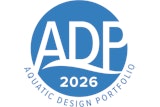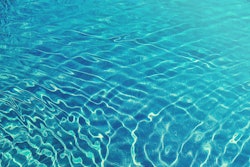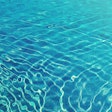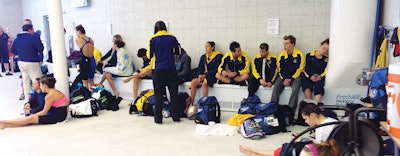
Maintaining an indoor aquatic center is no easy task, as anyone in the position of owning or operating one well knows. Every aspect must be carefully maintained to minimize the possibility of injury or illness and maximize the user's experience. Poor air quality in the natatorium environment can result in both — increased illness risk and decreased user comfort. Ongoing problems can also contribute to the deterioration of the facility itself, leading to costly repairs down the road.
There are many potential causes of air-quality issues, and often it's a combination of causes. "There's no one culprit," says Ralph Kittler, vice president of sales and marketing at Seresco USA, a Decatur, Ga.-based manufacturer of natatorium dehumidifiers. "There are usually two or three things that need to be addressed. The free chlorine count could be off but your HVAC system is fine, and you'll have an air-quality problem. If the air distribution to the space is stratified, you may have good air up high and bad air down below. Sometimes it's a maintenance and operational issue."
Here's a look at how various components of the aquatic facility can contribute to poor air quality, and what can be done to remedy the situation:
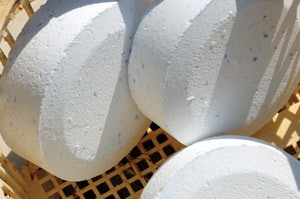 Photo Shutterstock.com/Arena Photo UK
Photo Shutterstock.com/Arena Photo UK
POOL CHEMISTRY
The most noticeable cause of air-quality issues in a pool is chloramines, a problem that has its root in the water. "In indoor pools, you have water that's going to react with the air," explains Jeff Boynton, general manager with Gardena, Calif.-based water treatment company Delta UV. "Most of the chemicals we put in the pool are going to evaporate. The more chemicals put into the water, the more chemical byproducts created. The more byproducts, the more likely we are to have air-quality problems."
The Model Aquatic Health Code suggests using a two-pillar approach to minimizing off-gassing: proper filtration and sanitation. "The idea is to have a properly sized sanitation device and filtration," Boynton says. "If the sanitation system isn't properly sized, you can be burning more chlorine, which is going to generate more byproducts. If you've got a small pool with a big pump and filter, the water is going to shoot through the filter so fast that it's going to create chimneys and not filter everything correctly."
Chlorine-based disinfection systems are the first line of defense for most aquatic facilities, but while some chlorine (or another halogen, such as bromine) is essential to the disinfection process, there are ways to reduce its use. "You can have a secondary or supplemental sanitation device such as ozone, UV, hydrolysis or electrolysis," Boynton says. "These devices are there to minimize the amount of chemicals that are being put in the pool by eradicating waterborne pathogens."
There is a difference between the two types, Boynton cautions. Under the recommendations of the MAHC, a secondary disinfection system would be required for new or renovated aquatic venues designed primarily for children under the age of five, as well as therapy pools. Supplemental systems, in contrast, are an option "for the purpose of enhancing overall system performance and improving water quality," Boynton adds, but aren't to be relied upon as a primary line of defense against contaminants.
RELATED: Dehumidifiers Help Maintain Air Quality in Natatoriums
POOR INITIAL DESIGN
Even if everything in the pool is operating efficiently, if the consulting engineer didn't specify the mechanical requirements properly, problems will be inevitable. There are requirements for how much outside air must be brought in and how often the air should be turned over. "Outside air is very expensive," says Kittler, an American Society of Heating, Refrigerating and Air-Conditioning Engineers distinguished lecturer and technical committee member. Outside air needs to be heated and filtered, processes that use energy and add to operating cost. Modern methods typically focus on reconditioning and recirculating existing air, while bringing in some outside air to help maintain good air quality, Kittler says. "Local codes will dictate what the minimum amounts of outdoor air are to provide good air quality. The amount of outdoor air recommended by ASHRAE Standard 62 should be sufficient for flat water pools, and more is really not necessary if the air distribution is done well."
ASHRAE is the go-to resource for most of the air-handling requirements in the natatorium, and the first edition of the MAHC defers to ASHRAE in its specifications, including ASHRAE standard 62.1 2013, Ventilation for Acceptable Indoor Air Quality, and ASHRAE Handbook – HVAC Applications 2011, Places of Assembly, Natatoriums. While those standards are a good starting point, they aren't all-inclusive, Kittler says. "Pretty much all design guides today were written for flat-water pools — outside air ventilation codes, air-exchange rates."
RELATED: Air Apparent
Today's aquatic centers, however, are more akin to water parks, with lazy rivers, water slides, fountains and more. It's a more complex setup than a traditional flat-water pool and requires a more complex set of calculations to determine the necessary air-handling needs. "Issues tend to be amplified in water parks because the density of the water features gives you more evaporation per square foot," Kittler says. "You're looking not just at a flat body of water; you might have water at two feet above that water level and 10 feet dripping down. Every single water feature is effectively a separate body of water, and each one should be calculated individually for its contribution to the total evaporation rate."
Not only do aquatic play features contribute to a higher evaporation load, but they also can contribute to increased chloramine production, Kittler says. "Free chlorines are going to get eaten up faster because you don't have the mass of residual in the huge body of water," he explains.
Kittler says ASHRAE is working on a chapter dedicated to indoor pool design to save engineers the confusion of jumping between multiple handbooks.
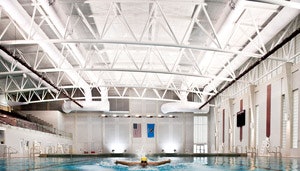 Photo by Melisa Lukenbaugh
Photo by Melisa Lukenbaugh
AIR DISTRIBUTION
Getting the right amount of fresh air into a facility is only half the problem, says Kittler. "You can have plenty of air to work with, but if the distribution is not done correctly, you'll have an air-quality issue," he says. "You need to get the good air down into the breathing zone where the people are."
Where the people are is also most often where the "bad air" is, says Derek Ingram, director of design and processing for Rock Hill, S.C.-based Paddock Evacuator. "Trichloramines are heavier than oxygen, so they're going to sit lower in the air. That breathing zone is going to have the worst air quality."
Building codes require that some fresh air be brought into the natatorium environment, which means some older air also has to be exhausted. Paddock Evacuator is a unique source-capture system aimed at capturing the bad air at the pool surface and pulling it into the exhaust. "The exhaust that is necessary through code, we're making that the most effective exhaust," explains Mark Weber, a sales and marketing representative with Paddock. "We're able to eliminate as much of the chloramines as possible to keep them out of the HVAC system so that it's recirculating clean air."
The system can be a lifesaver for aquatic facilities with serious air-quality issues, though it might take some work to make it fit existing infrastructure. "It doesn't necessarily work with what's already designed," Weber says. "It's common for us to have to redesign ductwork to make an efficient system."
The Evacuator is becoming a common choice for new pool construction, where its design can be incorporated into the gutter system. For retrofit applications, bench systems are easiest, says Ingram, noting that they serve a dual-purpose, replacing aluminum benches or chairs. A third possibility, depending on the owner's preference or the facility design, is a wall-mounted unit.
 Photo Shutterstock.com/Herbert Kratky
Photo Shutterstock.com/Herbert Kratky
THE USER FACTOR
Rarely are the actions of pool users themselves significant enough to cause air-quality issues, but in an environment already struggling, the bather load can exacerbate a problem. "We have a project we finished a year ago — a facility that had poor air quality, and it was a brand new facility," says Gary Gripp, a commercial service manager with Wilsonville, Ore.-based Anderson Poolworks. "We ruled out anything pool-related and found they had an excessive bather load, did not meet requirements for the air turnover load and had a constant struggle. A UV system helped diminish a lot of issues with chloramines, but on the heavier days, there would be a bit of a lag. That's a worst-case scenario."
For facilities that host everything from open swim to large-scale swim meets, understanding how much use the pool can take is essential. "Let's say you can have 150 people in a pool at a time," poses Gripp. "Now let's say you turn them over six or seven times in a day — everyone who gets into that pool is bringing in more contaminants. The chlorine demand goes up. You add more chlorine, you add something to counteract pH, you start to get more chloramines, and the air quality is terrible by the end of the day."
Such conditions should be anticipated in the design phase, and then double-checked after the facility is up and running. "There are some things that are lost in translation in the construction process," Gripp says. "These air-handling units have to go through a balancing process. You first start them up and things are perfect. But then you start to introduce bathers into the pool and throw that off. The system might be chasing its tail and someone needs to come out, reprogram it and find a perfect balance."
Paddock's Weber also recommends installing an HVAC system that can be adjusted for such fluctuations in bather load. "It's best to design larger than necessary, but allow the system to operate at minimum," he says. "Should you be running a large swim meet, you have the capacity to increase the circulation, circulate more outside air and alleviate some of those issues."
The natatorium is a complex environment, and ensuring a good user experience requires careful attention and balance of myriad factors. "There's no silver bullet when it comes to air quality," Kittler says. "If somebody does a good job on the air system and then the owner invests in UV or a source-capture or both, that's going to give you the best experience by a mile."
This article originally appeared in the November | December 2015 issue of Athletic Business with the title "Understanding the Causes of Poor Pool Air Quality"














